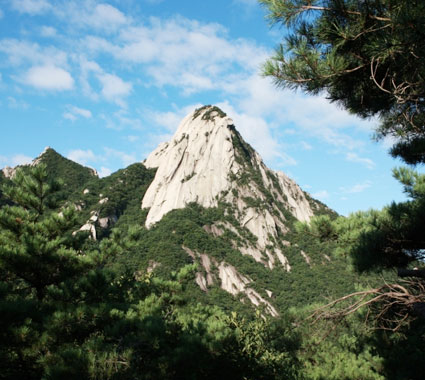- home
- Cultural Heritage
- State-Designated Heritage
- Samgaksan Mountain
Samgaksan Mountain

- Classification Scenic Site
- Designated Date 2003.10.31
- Area 274,143m² (Designated Area)
-
Location
- San 1-1 Bukhan-dong, Deogyang-gu, Goyang, Gyeonggi-do San 68-1 Ui-dong, Gangbuk-gu, Seoul
Samgaksan Mountain, refers to the summit of Bukhansan Mountain, consists of three peaks: Baegundae (836.5m), Insubong (810.5m), and Mangyeongdae (787.0m). These biotite granite peaks, formed in the late Jurassic period, are beautiful domes of different shapes that form wonderful natural scenery. The domes are inclined at more than 70 degrees. The top of Baegundae Peak is a flat open area of around 500m2 that is popular among hikers and tourists alike. Mangyeongdae Peak, formerly called Gungmangbong Peak, is rugged at the top. Due to its outstanding beauty, Samgaksan Mountain has attracted many visitors since olden times. According to a local legend, Onjo and Biryu, sons of King Dongmyeong of Goguryeo, travelled south and, upon reaching Hansan, climbed Buaak Mountain during their search for a suitable site for a settlement. (Buaak refers to Samgaksan Mountain, or more specifically, Insubong Peak.) According to another tale, while the Buddhist Monk Muhak was traveling around the country looking for a suitable site for the new capital of Joseon, he walked from Baegundae Peak to Mangyeongdae Peak, and then southwest to Bibong Peak. There he found a memorial with the inscription, “Muhak lost his way and reached this spot,” so he changed course and walked back down the mountain, and chose the site of Gyeongbokgung Palace. Samgaksan Mountain is also famous for the verse left by the scholar-official Kim Sang-heon as he was dragged off to China in the second Manchu Invasion of Joseon: “Good-bye Samgaksan Mountain, See you again, Hangang River…”
* Source : Korea Heritage Service

